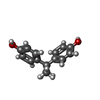[English] 日本語
 Yorodumi
Yorodumi- PDB-3uu7: Crystal structure of hERa-LBD (Y537S) in complex with bisphenol-A -
+ Open data
Open data
- Basic information
Basic information
| Entry | Database: PDB / ID: 3uu7 | ||||||
|---|---|---|---|---|---|---|---|
| Title | Crystal structure of hERa-LBD (Y537S) in complex with bisphenol-A | ||||||
 Components Components |
| ||||||
 Keywords Keywords |  HORMONE RECEPTOR / Ligand-binding domain of nuclear hormone receptor HORMONE RECEPTOR / Ligand-binding domain of nuclear hormone receptor | ||||||
| Function / homology |  Function and homology information Function and homology informationlabyrinthine layer morphogenesis / regulation of thyroid hormone mediated signaling pathway / positive regulation of transcription from RNA polymerase II promoter by galactose / positive regulation of female receptivity / regulation of epithelial cell apoptotic process / antral ovarian follicle growth / G protein-coupled estrogen receptor activity / hypothalamus development / regulation of branching involved in prostate gland morphogenesis / male mating behavior ...labyrinthine layer morphogenesis / regulation of thyroid hormone mediated signaling pathway / positive regulation of transcription from RNA polymerase II promoter by galactose / positive regulation of female receptivity / regulation of epithelial cell apoptotic process / antral ovarian follicle growth / G protein-coupled estrogen receptor activity / hypothalamus development / regulation of branching involved in prostate gland morphogenesis / male mating behavior / RUNX1 regulates transcription of genes involved in WNT signaling / NR1H2 & NR1H3 regulate gene expression to control bile acid homeostasis / RUNX1 regulates estrogen receptor mediated transcription /  regulation of toll-like receptor signaling pathway / prostate epithelial cord arborization involved in prostate glandular acinus morphogenesis / nuclear estrogen receptor activity / epithelial cell proliferation involved in mammary gland duct elongation / prostate epithelial cord elongation / epithelial cell development / negative regulation of smooth muscle cell apoptotic process / mammary gland branching involved in pregnancy / uterus development / vagina development / androgen metabolic process / TFIIB-class transcription factor binding / steroid hormone mediated signaling pathway / regulation of toll-like receptor signaling pathway / prostate epithelial cord arborization involved in prostate glandular acinus morphogenesis / nuclear estrogen receptor activity / epithelial cell proliferation involved in mammary gland duct elongation / prostate epithelial cord elongation / epithelial cell development / negative regulation of smooth muscle cell apoptotic process / mammary gland branching involved in pregnancy / uterus development / vagina development / androgen metabolic process / TFIIB-class transcription factor binding / steroid hormone mediated signaling pathway /  estrous cycle / cellular response to Thyroglobulin triiodothyronine / Synthesis of bile acids and bile salts / mammary gland alveolus development / intracellular estrogen receptor signaling pathway / cellular response to estrogen stimulus / estrous cycle / cellular response to Thyroglobulin triiodothyronine / Synthesis of bile acids and bile salts / mammary gland alveolus development / intracellular estrogen receptor signaling pathway / cellular response to estrogen stimulus /  estrogen response element binding / Endogenous sterols / Synthesis of bile acids and bile salts via 27-hydroxycholesterol / Synthesis of bile acids and bile salts via 7alpha-hydroxycholesterol / positive regulation of phospholipase C activity / nuclear retinoid X receptor binding / intracellular steroid hormone receptor signaling pathway / response to retinoic acid / negative regulation of canonical NF-kappaB signal transduction / Nuclear signaling by ERBB4 / RNA polymerase II preinitiation complex assembly / estrogen response element binding / Endogenous sterols / Synthesis of bile acids and bile salts via 27-hydroxycholesterol / Synthesis of bile acids and bile salts via 7alpha-hydroxycholesterol / positive regulation of phospholipase C activity / nuclear retinoid X receptor binding / intracellular steroid hormone receptor signaling pathway / response to retinoic acid / negative regulation of canonical NF-kappaB signal transduction / Nuclear signaling by ERBB4 / RNA polymerase II preinitiation complex assembly /  histone acetyltransferase activity / regulation of cellular response to insulin stimulus / Recycling of bile acids and salts / histone acetyltransferase activity / regulation of cellular response to insulin stimulus / Recycling of bile acids and salts /  histone acetyltransferase / cellular response to hormone stimulus / NR1H3 & NR1H2 regulate gene expression linked to cholesterol transport and efflux / protein localization to chromatin / positive regulation of adipose tissue development / peroxisome proliferator activated receptor signaling pathway / RORA activates gene expression / TBP-class protein binding / histone acetyltransferase / cellular response to hormone stimulus / NR1H3 & NR1H2 regulate gene expression linked to cholesterol transport and efflux / protein localization to chromatin / positive regulation of adipose tissue development / peroxisome proliferator activated receptor signaling pathway / RORA activates gene expression / TBP-class protein binding /  lactation / TFAP2 (AP-2) family regulates transcription of growth factors and their receptors / lactation / TFAP2 (AP-2) family regulates transcription of growth factors and their receptors /  steroid binding / positive regulation of neuron differentiation / Regulation of lipid metabolism by PPARalpha / nitric-oxide synthase regulator activity / cerebellum development / ESR-mediated signaling / BMAL1:CLOCK,NPAS2 activates circadian gene expression / 14-3-3 protein binding / transcription corepressor binding / SUMOylation of transcription cofactors / Activation of gene expression by SREBF (SREBP) / negative regulation of miRNA transcription / nuclear receptor coactivator activity / response to progesterone / cellular response to estradiol stimulus / steroid binding / positive regulation of neuron differentiation / Regulation of lipid metabolism by PPARalpha / nitric-oxide synthase regulator activity / cerebellum development / ESR-mediated signaling / BMAL1:CLOCK,NPAS2 activates circadian gene expression / 14-3-3 protein binding / transcription corepressor binding / SUMOylation of transcription cofactors / Activation of gene expression by SREBF (SREBP) / negative regulation of miRNA transcription / nuclear receptor coactivator activity / response to progesterone / cellular response to estradiol stimulus /  transcription coregulator binding / nuclear estrogen receptor binding / transcription coregulator binding / nuclear estrogen receptor binding /  stem cell differentiation / positive regulation of nitric-oxide synthase activity / stem cell differentiation / positive regulation of nitric-oxide synthase activity /  nuclear receptor binding / hippocampus development / RNA polymerase II transcription regulatory region sequence-specific DNA binding / Heme signaling / nuclear receptor binding / hippocampus development / RNA polymerase II transcription regulatory region sequence-specific DNA binding / Heme signaling /  euchromatin / SUMOylation of intracellular receptors / mRNA transcription by RNA polymerase II / Transcriptional activation of mitochondrial biogenesis / negative regulation of DNA-binding transcription factor activity / euchromatin / SUMOylation of intracellular receptors / mRNA transcription by RNA polymerase II / Transcriptional activation of mitochondrial biogenesis / negative regulation of DNA-binding transcription factor activity /  transcription coactivator binding / PPARA activates gene expression / Cytoprotection by HMOX1 / cerebral cortex development / transcription coactivator binding / PPARA activates gene expression / Cytoprotection by HMOX1 / cerebral cortex development /  beta-catenin binding / Transcriptional regulation of white adipocyte differentiation / Nuclear Receptor transcription pathway / response to estrogen / RNA polymerase II transcription regulator complex / male gonad development / Constitutive Signaling by Aberrant PI3K in Cancer / Regulation of RUNX2 expression and activity / beta-catenin binding / Transcriptional regulation of white adipocyte differentiation / Nuclear Receptor transcription pathway / response to estrogen / RNA polymerase II transcription regulator complex / male gonad development / Constitutive Signaling by Aberrant PI3K in Cancer / Regulation of RUNX2 expression and activity /  nuclear receptor activity / positive regulation of nitric oxide biosynthetic process / positive regulation of DNA-binding transcription factor activity / positive regulation of fibroblast proliferation nuclear receptor activity / positive regulation of nitric oxide biosynthetic process / positive regulation of DNA-binding transcription factor activity / positive regulation of fibroblast proliferationSimilarity search - Function | ||||||
| Biological species |   Homo sapiens (human) Homo sapiens (human) | ||||||
| Method |  X-RAY DIFFRACTION / X-RAY DIFFRACTION /  SYNCHROTRON / SYNCHROTRON /  MOLECULAR REPLACEMENT / Resolution: 2.196 Å MOLECULAR REPLACEMENT / Resolution: 2.196 Å | ||||||
 Authors Authors | Delfosse, V. / Grimaldi, M. / Bourguet, W. | ||||||
 Citation Citation |  Journal: Proc.Natl.Acad.Sci.USA / Year: 2012 Journal: Proc.Natl.Acad.Sci.USA / Year: 2012Title: Structural and mechanistic insights into bisphenols action provide guidelines for risk assessment and discovery of bisphenol A substitutes. Authors: Delfosse, V. / Grimaldi, M. / Pons, J.L. / Boulahtouf, A. / le Maire, A. / Cavailles, V. / Labesse, G. / Bourguet, W. / Balaguer, P. | ||||||
| History |
|
- Structure visualization
Structure visualization
| Structure viewer | Molecule:  Molmil Molmil Jmol/JSmol Jmol/JSmol |
|---|
- Downloads & links
Downloads & links
- Download
Download
| PDBx/mmCIF format |  3uu7.cif.gz 3uu7.cif.gz | 115.3 KB | Display |  PDBx/mmCIF format PDBx/mmCIF format |
|---|---|---|---|---|
| PDB format |  pdb3uu7.ent.gz pdb3uu7.ent.gz | 87.9 KB | Display |  PDB format PDB format |
| PDBx/mmJSON format |  3uu7.json.gz 3uu7.json.gz | Tree view |  PDBx/mmJSON format PDBx/mmJSON format | |
| Others |  Other downloads Other downloads |
-Validation report
| Arichive directory |  https://data.pdbj.org/pub/pdb/validation_reports/uu/3uu7 https://data.pdbj.org/pub/pdb/validation_reports/uu/3uu7 ftp://data.pdbj.org/pub/pdb/validation_reports/uu/3uu7 ftp://data.pdbj.org/pub/pdb/validation_reports/uu/3uu7 | HTTPS FTP |
|---|
-Related structure data
| Related structure data |  3uuaC  3uucC  3uudC  3l03S C: citing same article ( S: Starting model for refinement |
|---|---|
| Similar structure data |
- Links
Links
- Assembly
Assembly
| Deposited unit | 
| ||||||||
|---|---|---|---|---|---|---|---|---|---|
| 1 |
| ||||||||
| 2 | 
| ||||||||
| 3 | 
| ||||||||
| Unit cell |
|
- Components
Components
| #1: Protein |  / ER / ER-alpha / Estradiol receptor / Nuclear receptor subfamily 3 group A member 1 / ER / ER-alpha / Estradiol receptor / Nuclear receptor subfamily 3 group A member 1Mass: 28656.742 Da / Num. of mol.: 1 / Fragment: Ligand binding domain (residues 302-552) / Mutation: Y537S Source method: isolated from a genetically manipulated source Source: (gene. exp.)   Homo sapiens (human) / Gene: ESR1, ESR, NR3A1 / Plasmid: pET32a / Production host: Homo sapiens (human) / Gene: ESR1, ESR, NR3A1 / Plasmid: pET32a / Production host:   Escherichia coli (E. coli) / Strain (production host): BL21(DE3) / References: UniProt: P03372 Escherichia coli (E. coli) / Strain (production host): BL21(DE3) / References: UniProt: P03372 | ||||
|---|---|---|---|---|---|
| #2: Protein |  / ER / ER-alpha / Estradiol receptor / Nuclear receptor subfamily 3 group A member 1 / ER / ER-alpha / Estradiol receptor / Nuclear receptor subfamily 3 group A member 1Mass: 28672.742 Da / Num. of mol.: 1 / Fragment: Ligand binding domain (residues 302-552) / Mutation: Y537S Source method: isolated from a genetically manipulated source Source: (gene. exp.)   Homo sapiens (human) / Gene: ESR1, ESR, NR3A1 / Plasmid: pET32a / Production host: Homo sapiens (human) / Gene: ESR1, ESR, NR3A1 / Plasmid: pET32a / Production host:   Escherichia coli (E. coli) / Strain (production host): BL21(DE3) / References: UniProt: P03372 Escherichia coli (E. coli) / Strain (production host): BL21(DE3) / References: UniProt: P03372 | ||||
| #3: Protein/peptide |  / NCoA-1 / Class E basic helix-loop-helix protein 74 / bHLHe74 / Protein Hin-2 / RIP160 / Renal ...NCoA-1 / Class E basic helix-loop-helix protein 74 / bHLHe74 / Protein Hin-2 / RIP160 / Renal carcinoma antigen NY-REN-52 / Steroid receptor coactivator 1 / SRC-1 / NCoA-1 / Class E basic helix-loop-helix protein 74 / bHLHe74 / Protein Hin-2 / RIP160 / Renal ...NCoA-1 / Class E basic helix-loop-helix protein 74 / bHLHe74 / Protein Hin-2 / RIP160 / Renal carcinoma antigen NY-REN-52 / Steroid receptor coactivator 1 / SRC-1Mass: 1591.880 Da / Num. of mol.: 2 / Fragment: Coactivator peptide SRC-1 / Source method: obtained synthetically / Details: synthesized peptide / Source: (synth.)   Homo sapiens (human) / References: UniProt: Q15788, Homo sapiens (human) / References: UniProt: Q15788,  histone acetyltransferase histone acetyltransferase#4: Chemical |  Bisphenol A Bisphenol A#5: Water | ChemComp-HOH / |  Water Water |
-Experimental details
-Experiment
| Experiment | Method:  X-RAY DIFFRACTION / Number of used crystals: 1 X-RAY DIFFRACTION / Number of used crystals: 1 |
|---|
- Sample preparation
Sample preparation
| Crystal | Density Matthews: 2.02 Å3/Da / Density % sol: 39.24 % |
|---|---|
Crystal grow | Temperature: 291 K / Method: vapor diffusion, hanging drop / pH: 7.75 Details: 300 mM NaCl, 100 mM NaHepes pH 7.75, 30% PEG 3350, VAPOR DIFFUSION, HANGING DROP, temperature 291K |
-Data collection
| Diffraction | Mean temperature: 100 K |
|---|---|
| Diffraction source | Source:  SYNCHROTRON / Site: SYNCHROTRON / Site:  ESRF ESRF  / Beamline: ID14-1 / Wavelength: 0.9334 Å / Beamline: ID14-1 / Wavelength: 0.9334 Å |
| Detector | Type: ADSC QUANTUM 210 / Detector: CCD / Date: May 2, 2011 |
| Radiation | Monochromator: Diamond (111), Ge(220) / Protocol: SINGLE WAVELENGTH / Monochromatic (M) / Laue (L): M / Scattering type: x-ray |
| Radiation wavelength | Wavelength : 0.9334 Å / Relative weight: 1 : 0.9334 Å / Relative weight: 1 |
| Reflection | Resolution: 2.196→46.53 Å / Num. all: 24610 / Num. obs: 24610 / % possible obs: 99.55 % / Observed criterion σ(F): 0 / Observed criterion σ(I): 0 / Redundancy: 3.8 % / Biso Wilson estimate: 28.91 Å2 / Rsym value: 0.0106 / Net I/σ(I): 8.43 |
| Reflection shell | Resolution: 2.2→2.33 Å / Redundancy: 3.8 % / Mean I/σ(I) obs: 2.96 / Num. unique all: 3876 / Rsym value: 0.432 / % possible all: 99.2 |
- Processing
Processing
| Software |
| ||||||||||||||||||||||||||||||||||||||||||||||||||||||||||||||||||||||
|---|---|---|---|---|---|---|---|---|---|---|---|---|---|---|---|---|---|---|---|---|---|---|---|---|---|---|---|---|---|---|---|---|---|---|---|---|---|---|---|---|---|---|---|---|---|---|---|---|---|---|---|---|---|---|---|---|---|---|---|---|---|---|---|---|---|---|---|---|---|---|---|
| Refinement | Method to determine structure : :  MOLECULAR REPLACEMENT MOLECULAR REPLACEMENTStarting model: PDB ENTRY 3L03 Resolution: 2.196→46.526 Å / SU ML: 0.26 / σ(F): 1.99 / Phase error: 26.68 / Stereochemistry target values: ML
| ||||||||||||||||||||||||||||||||||||||||||||||||||||||||||||||||||||||
| Solvent computation | Shrinkage radii: 0.83 Å / VDW probe radii: 1.1 Å / Solvent model: FLAT BULK SOLVENT MODEL / Bsol: 49.365 Å2 / ksol: 0.368 e/Å3 | ||||||||||||||||||||||||||||||||||||||||||||||||||||||||||||||||||||||
| Displacement parameters |
| ||||||||||||||||||||||||||||||||||||||||||||||||||||||||||||||||||||||
| Refinement step | Cycle: LAST / Resolution: 2.196→46.526 Å
| ||||||||||||||||||||||||||||||||||||||||||||||||||||||||||||||||||||||
| Refine LS restraints |
| ||||||||||||||||||||||||||||||||||||||||||||||||||||||||||||||||||||||
| LS refinement shell | Refine-ID: X-RAY DIFFRACTION
|
 Movie
Movie Controller
Controller



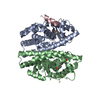
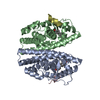

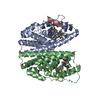
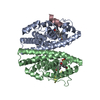




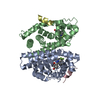
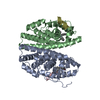

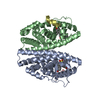
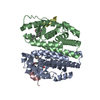
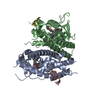
 PDBj
PDBj
















